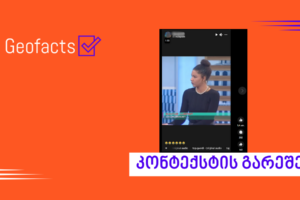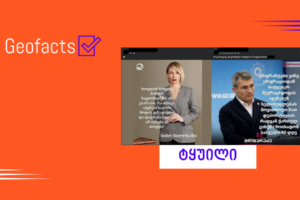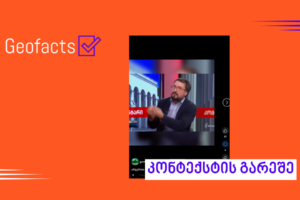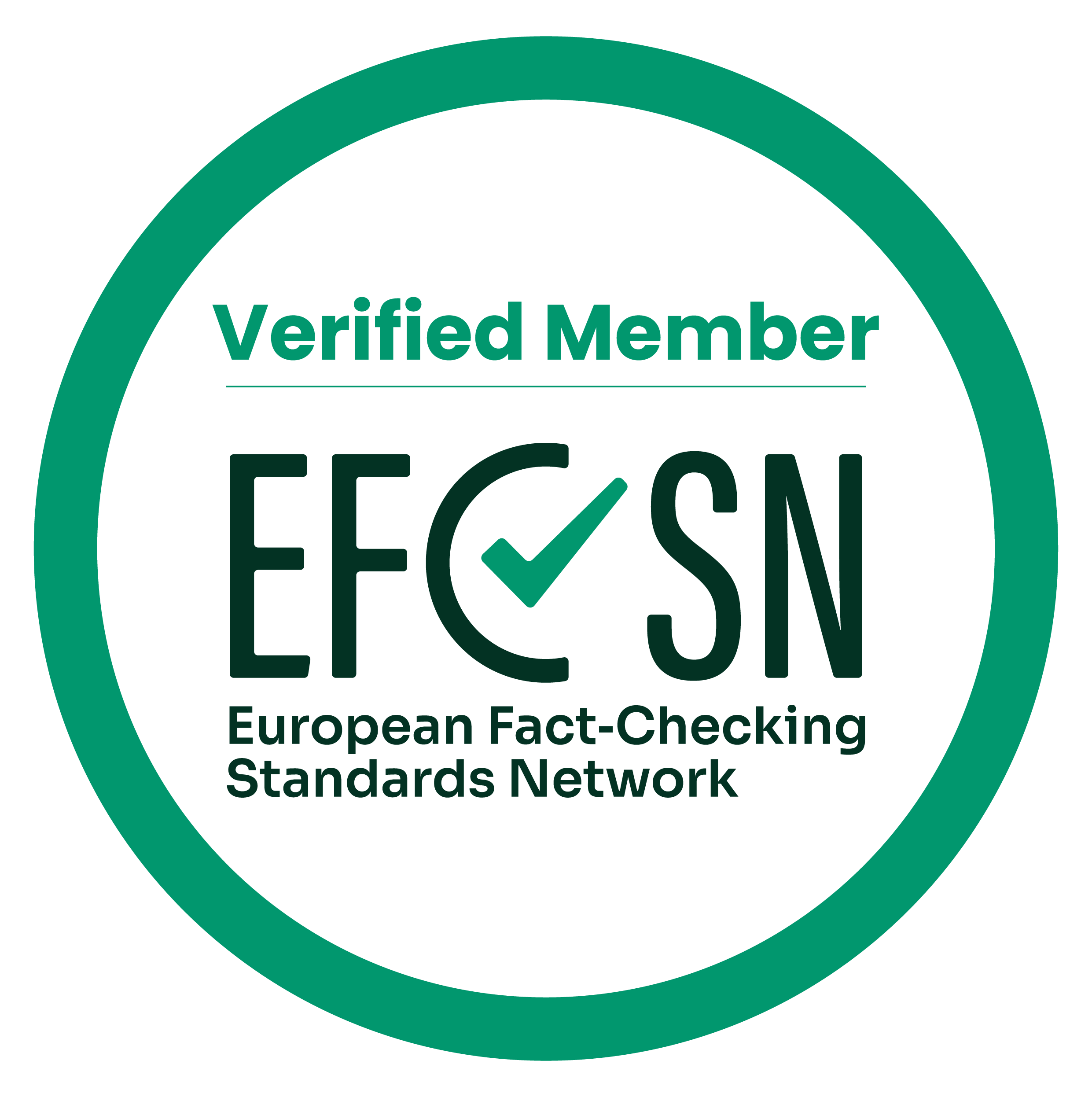The working principle of “GeoFacts” is based on the principles and standards developed by the International Fact Checking Network (IFCN) and the European Fact-Checking Standards Network (EFCSN).
“GeoFacts” aims to:
- Provide the public with verified and fact-based information.
- Ensure transparent methodology and fact-checking process, enabling readers to independently verify sources and confirm authenticity.
- Promote critical thinking and media literacy.
“GeoFacts” only advocates on issues concerning of fight against disinformation, media, and fact-checking topics.
How does “GeoFacts“ work
Finding claims to verify
“GeoFacts” checks facts, therefore the claim that “GeoFacts” analysts investigate must be verifiable and distinguished from opinion (while opinions themselves are not fact-checked, any factual claims within opinions are subject to verification).”GeoFacts” checks both statements made by politicians and other factual claims circulating on social networks or media, focusing on issues of public interest.
How do we find facts to verify?
To find facts for verification, “GeoFacts” analysts keep up with daily events in the country, monitor parliamentary and government sessions, politicians’ speeches, materials published by politicians or public figures on social networks, election party advertisements, party election programs, etc.
“GeoFacts” also examines claims spread on social networks that are publicly published by accounts other than politicians. In this case too, “GeoFacts” checks claims that address important societal issues and may mislead users. For this purpose, “GeoFacts” analysts monitor Meta platforms, Facebook and Instagram, as well as TikTok, Telegram and YouTube.
In addition to its internal monitoring system, “GeoFacts” offers a fact-checking service for readers. Readers can submit claims for verification via email or through the “Submit a fact to check” button on the website. They can also contact “GeoFacts” on its Facebook page.
How we select claims to verify
When selecting a claim to verify, “GeoFacts” considers several criteria:
- Verifiability of the claim – A politician’s statement, video, photo, or text shared on social networks that “GeoFacts” chooses to verify must be fact-based. “GeoFacts” does not verify opinions, although it will check any facts presented within those opinions. Additionally, “GeoFacts” generally does not evaluate future predictions, except in cases where fundamentally irrational predictions can be proven impossible to realize.
- Public interest and virality of the claim – It is impossible to verify every claim spread in the information space. Therefore, when selecting a topic, “GeoFacts” also considers public interest – how interesting is this issue for the public? It is according to this criterion that readers will often see articles on the “GeoFacts” website on issues such as: unemployment, healthcare policy, foreign policy, etc. When verifying claims spread on social networks, “GeoFacts” also considers the current or potential reach of the post, in addition to the importance of the issue to the public.
- Impact on society – “GeoFacts” draws special attention to verifying misleading information that can: a) endanger people’s health and live; b) endanger democratic processes, especially if it damages the credibility of the elections; c) damage the process of European and Euro-Atlantic integration of Georgia guaranteed by the Constitution of Georgia. In crisis situations, false information can cause even more damage. Therefore, “GeoFacts” prioritizes checking information spread about natural disasters, epidemics/pandemics, political crises, large-scale protests, and other similarly significant events.
“GeoFacts” does not attach importance to who spreads a particular claim. What is important for “GeoFacts” is the content of the claim itself and how important the issue is for the public. However, we pay special attention to statements/claims made by high-ranking officials, for example, the Prime Minister, President, Speaker of Parliament, as their statements and promises have a direct impact on public life. Additionally, especially during the pre-election period, “GeoFacts” strives to equally cover claims made by all parties involved in the discussion to ensure balanced reporting.
After selecting a claim to verify, the editor and analyst of “GeoFacts” determine exactly what is subject to verification in the given claim and fact-check preparation begins only after the claims to be verified are clarified. Some statements may contain several claims. In such cases, depending on the importance of the claims and their interdependence, the editor of “GeoFacts” decides whether to respond to them with a single article or to devote a separate article to each claim. Also, often the same misleading information is spread by different sources in a coordinated or uncoordinated manner. In such cases too, depending on the importance of the issue, the editor decides whether to respond to them with separate articles or devote a single article.
Fact-checking – Article preparation
Once the “GeoFacts” analyst and editor determine a specific verifiable claim, the fact-checking process begins.
Clarifying the claim
If the claim or part of it is unclear and it is impossible to determine the exact quote using other sources (for example, if a politician repeats a specific phrase at the same briefing or dedicates a post to the issue on social networks, allowing the analyst to independently clarify the quote containing the claim), the “GeoFacts” analyst contacts the author of the claim to clarify the quote.
However, often, especially politicians and public figures, try to embellish the claim when contacted for clarification. In such cases, “GeoFacts” considers each instance individually and generally prioritizes the publicly disseminated claim. The publicly disseminated claim is what may mislead citizens, while the claim clarified in a private conversation with the “GeoFacts” analyst is not available to a wide audience. In such a case, “GeoFacts” evaluates the original claim with a verdict, but attaches the explanation to the article made by the author of the claim.
Verification process
For fact-checking, the “GeoFacts” analyst utilizes all reliable information available in various forms to determine the accuracy of the claim. This information can be found using search engines and through detailed searches on specific authoritative sources. Examples include websites of state agencies, where the analyst can find exact indicators and statistical information or clarify legislative records. During the verification process, the analyst reviews primary sources related to the claim, checks the origin of the information, and investigates the authenticity of photo, video, and audio materials if necessary.
During verification process, “GeoFacts” also relies on reports from various authoritative international and local organizations on the issues in question. The analyst reviews peer-reviewed scientific journals and, if necessary, requests information from public agencies in accordance with Georgian legislation.
In some cases, expert consultation or interviews are needed when verifying a claim. “GeoFacts” first seeks the expertise of a neutral expert professionally associated with the issue, whose insights are used as an argument in evaluating the verdict in the article. If experts are affiliated with the government or opposition in any way, and their opinion is included to better understand the issue, their professional affiliation or connection to a specific political association is clearly indicated when quoting them.
Article preparation
After gathering information, the “GeoFacts” analyst accumulates a substantial amount of data. Except in special cases, the analyst aims to condense this information into an 800-word article that is easily understandable for the reader. During the preparation of the article, all information and facts should be verified multiple times by both the analyst and the editor to ensure accuracy.
One of the main principles of “GeoFacts” is transparency and traceability of sources. All data, facts, and evidence used in the article are presented with corresponding links. This allows readers to independently verify the sources confirming each fact cited and gather the same information the analyst collected. It is crucial that analysts use primary sources whenever possible. “GeoFacts” typically cites at least two sources for fact-checking in each article. While primary sources are preferred, secondary sources may be used if primary ones are unavailable.
In addition, the analysts do not use anonymous sources when preparing fact-check, except in special cases where disclosure of the source’s identity may create security risks. In such exceptional cases, “GeoFacts” verifies the information with identifiable sources or other evidence.
“GeoFacts” fact-checking articles present evidence and facts. Analysts avoid using evaluative language or entries that may be interpreted as ideological evaluations or opinions.
When verifying information spread on social networks, “GeoFacts” inserts a screenshot of the spread story in the article, but conceals the publisher’s identification data (name, surname, photo) if the user unintentionally spreads false content and is not a repeat offender in spreading false information (this applies only to personal accounts that do not belong to public figures). With this, “GeoFacts” tries to protect unintentional spreaders from excessive publicity and possible online harassment. (See example)
Similarly, any photo/video material used in the article depicting a minor who is not a public figure, will be covered. The face of a minor may be partially covered if other verification possibilities are exhausted. Similarly, “GeoFacts” will not make the identity of a minor public unless they are a public figure or other means of verification are exhausted.
“GeoFacts” analysts take special care to protect personal information. “GeoFacts” will cover data that could facilitate harassment of a person, such as phone number, email, and address. Also, other personal data, e.g. ID number, will be fully or partially covered in “GeoFacts’” articles. In individual cases, the editorial board will discuss allowing exceptions and, in such cases, will rely on international professional standards.
Also, after preparing the article, “GeoFacts” may adapt the material for various social networks as digital material, short videos or long explainers. The analyst working on the issue is also involved in the process of adapting this material so that the main findings and evidence given in the fact-check are not lost.
See the “Fact-Checking Working Rules” that “GeoFacts” analysts follow when preparing articles in detail in the Link.
Verdict Assessment of the Article
The final stage of article preparation is the verdict assessment. For each article, the verdict is selected individually, taking into account specific criteria.
For “GeoFacts,” not only the nominal accuracy of the fact or statistic given in the claim is important, but also the context in which this claim was made. In some cases, a fact may seem to be accurately stated, but it creates an inaccurate impression without providing additional information. Moreover, sometimes, despite providing correct facts, the author of the statement/claim may mislead the audience by omitting a specific detail. In some cases, especially when reviewing statistical data, the author of the claim may only discuss data that is favorable to them, while omitting other relevant but unfavorable indicators. Such cases are particularly common when reviewing various international reports, where one side only talks about positive indicators from the report, while the other only about negative indicators.
Often, especially politicians, when speaking on various issues, use hyperbole for the purpose of exaggeration or other reasons, using phrases such as – unprecedented, record-breaking, anti-record, etc. Such claims are often exaggerated, which has a corresponding impact on the verdict assessment of the claim;
In some cases, the author of the claim/statement makes an unintentional mistake and does not aim to deceive the public. This becomes evident during the fact-checking process or the author of the claim may make an additional clarification. Nevertheless, misleading information provided to a wide audience still needs to be fact-checked to provide citizens with correct, fact-based information. In such cases, the editorial board decides whether to consider the explanation of the author of the claim/statement in the verdict assessment. The board’s decision will be clearly explained in the article.
In some cases, “GeoFacts” prepares a fact-based newspaper article on a topic of public interest, in which it does not assess various claims with a verdict at all and provides the reader with fact-based information on the given topic.
“GeoFacts” uses the following verdicts when evaluating a:
True – The claim is accurate and nothing significant is missing;
Mostly True – The claim is accurate, but needs additional information or explanation;
Half True – The claim is partially accurate, but important details are omitted or the issue is presented without context;
Mostly False – There is an element of truth in the claim, but it lacks critically important information that would create a different impression;
False – The claim is inaccurate
Lie – The claim is inaccurate and absurd
Missing Context – The facts presented in the claim are more or less accurate, but the context is deliberately distorted;
Altered – Photo/video/audio material is deliberately edited or altered, which misleads the public. This also includes media created or altered using artificial intelligence (AI).
Without Verdict – It is impossible to assess the claim with a verdict;
Satire – A claim that contains exaggerated fact, irony, satire, sarcasm, which an ordinary reader may not perceive as satire. Such claims may be from sources that are not widely known as satirical, or do not clearly indicate the satirical content of their posts.
Newspaper Article – An article prepared on a specific issue that does not specifically check a claim and does not include a verdict assessment.
Assessment of Position Change
In some cases, public figures who influence public opinion and views change their position. When a politician or other public figure is accused of changing their position, or when media notices such a change in position, or in cases where a “GeoFacts” reader has asked us to verify a change in position, “GeoFacts” also checks for position changes.
It is important to note that when checking for position changes, “GeoFacts” does not make moral judgments or evaluations of the position change. For some parts of the public, changing position is an indicator of compromise and pragmatism, while for others, an unchanging position is a sign of having solid values and principles.
As with the rest of the fact-checking program, the aim of “GeoFacts” in the context of checking position changes is to facilitate informed choice and provide fact-based accurate information to the public.
In materials prepared within the framework of position change verification, “GeoFacts” uses the following verdicts when assessing claims:
Position Change – Complete reversal of position;
Position Not Changed – The position and its tone of expression are essentially unchanged;
Position Partially Changed – The tone of expressing the position, or the position itself, has changed partially or has become inconsistent; the tone of expression has become stricter/softer.
Checking Political Promises
“GeoFacts” may also verify statements about promises made by politicians. As a rule, statements that refer to the future are not subject to verification, except in exceptional cases. When checking promises, “GeoFacts” has the opportunity to provide readers with information about the process of fulfilling a promise made earlier by a specific politician, for example – in the past election cycle.
In some cases, the content of the promise itself may be controversial from the perspective of different ideologies or theories, and the question – how necessary it is to implement what the politician promises – may not be subject to assessment as a fact criterion. “GeoFacts” limits itself to determining the factual part of promise fulfillment (namely – whether the promise was fulfilled) and does not enter into the part of ideological discussion. This direction of the fact-checking program stems from the goal of providing citizens with more information to make an informed choice.
When checking promises, “GeoFacts” uses the following verdicts:
Not Fulfilled – When the promise was not fulfilled at all, was stopped in the process of fulfillment, its fulfillment has not started or insignificant steps were taken, or it was fulfilled with such significant flaws that the promised goal was ruled out;
Partially Fulfilled – A promise, part of which was fulfilled, or was fulfilled with delay or part of it was fulfilled within the specified time while the process is still ongoing;
Fulfilled – The promise was fulfilled, and no significant flaws or delays were revealed in the process
In Progress – The promise is in the process of being fulfilled and the deadline set when it was made has not yet expired / a reasonable time remains until its expiration.
Preparation of the Final Article
Once the article takes its final form and the analyst considers that the claim fact-checked in the article is clearly formulated, all details are explained, sources are verified and cited, and the arguments based on which the claim was assessed with a specific verdict are explained, the editor begins to review the article. During editing, they may give both substantive comments as well as stylistic ones, and in this process, the article may be returned to the analyst several times. The final version of the article and the verdict are agreed between the editor and the analyst. When the analyst and editor cannot reach an agreement on the verdict of the article, the editorial board makes the decision by voting.
Publication of the Article
Once the article is approved for publication by the editor or the editorial board, the article is placed on the website. For this, the article undergoes technical editing in spelling and other grammar issues, as well as – in some cases simplifying the language for the reader. During technical editing, if an error is found, the technical editor also has the right to return the article to the editing stage once again. After publication, the article can be corrected within the framework of the correction policy in effect at “GeoFacts” (see below). After publication, the article is adapted for various materials with the involvement of the author of the fact-check and editor, adhering to the relevant standards.
Correction Policy
Mistakes happen and “GeoFacts” makes them too. However, it is important for “GeoFacts” that errors are corrected quickly and, most importantly, transparently.
An interested person can send a reasoned appeal for correction/complaint both via email ([email protected]) or our Facebook page. The reasoned appeal submitted with a request to correct the article is reviewed by the editorial board together with the author of the article. The editorial board is also authorized, if the board sees such a need, to invite the author of the correction letter to discuss the article.
The editorial board consists of three persons. Decisions at the editorial board are made by 2 votes. If, as a result of a reasoned appeal, the board decided to make changes to the article and such a correction was made that affected the verdict, the verdict changes.
In the case of corrections, “GeoFacts” clearly indicates (in the form of an editor’s note) the implemented change and the motivation behind it, specifying the argument used and at whose request or following communication with whom the need to implement the specific change was identified. This will be explained in the form of an editor’s note. In addition, the title of the article will contain the word “Correction”. In addition, “GeoFacts” republishes the article on social media page(s) and tries to reach the audience that was reached with the pre-change version.
Based on the reader’s feedback or by the decision of the “GeoFacts”, information that does not affect the verdict but provides the reader with additional or updated information may be added to the article after publication. In such cases, “GeoFacts” will update the article and inform the reader about the changes made in the form of an editor’s note.
Last updated – July, 2024
The editorial code is based on the methodology of American Politifact, Spanish Maldita.es, and Georgian FactCheck.ge.






